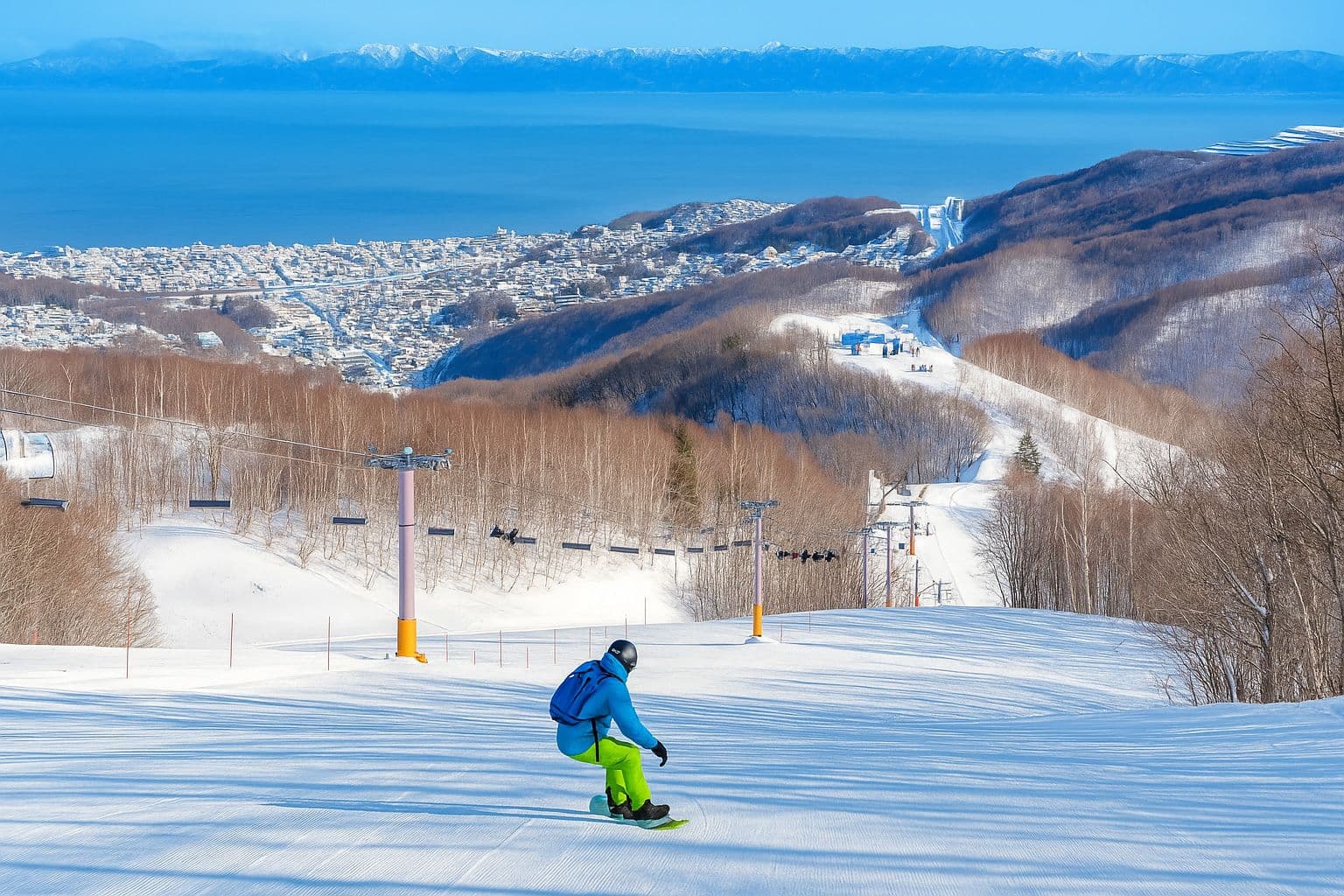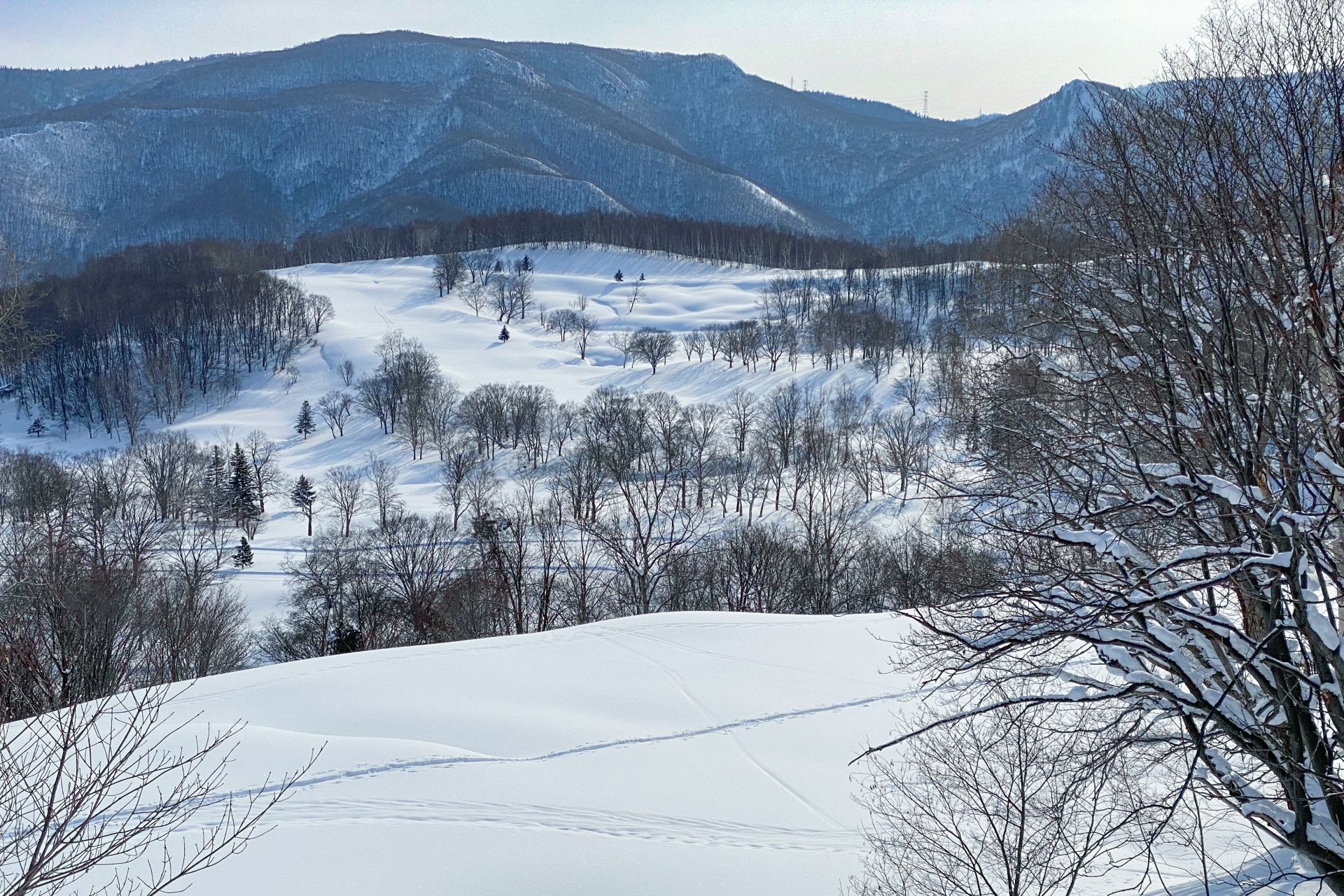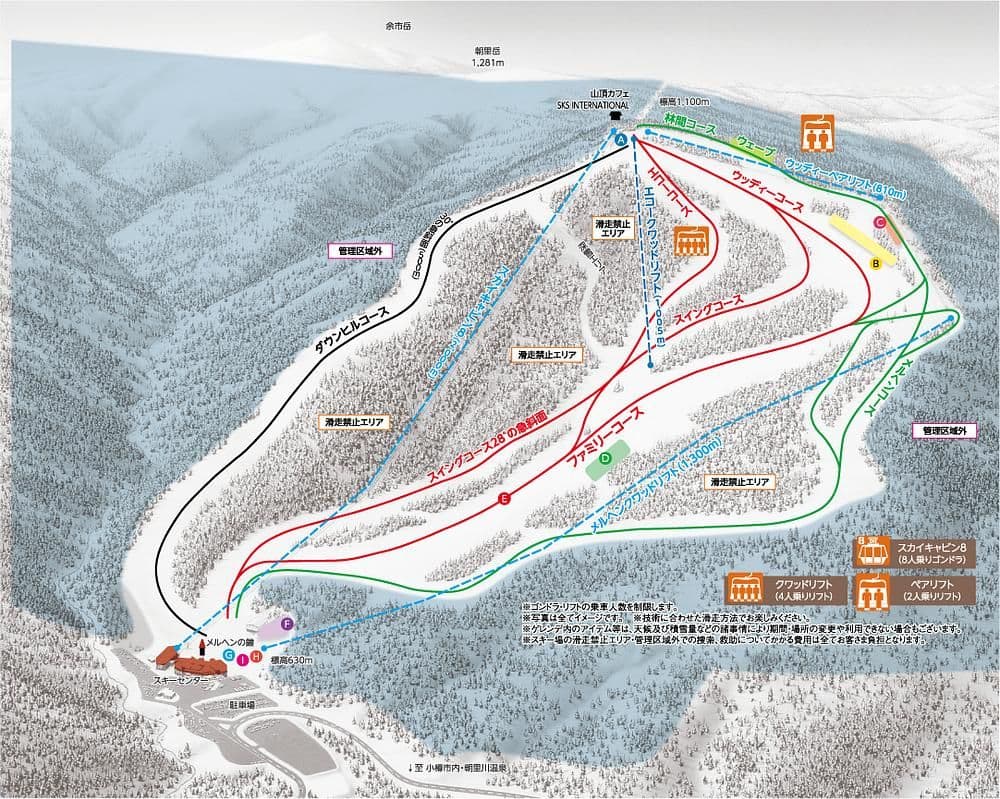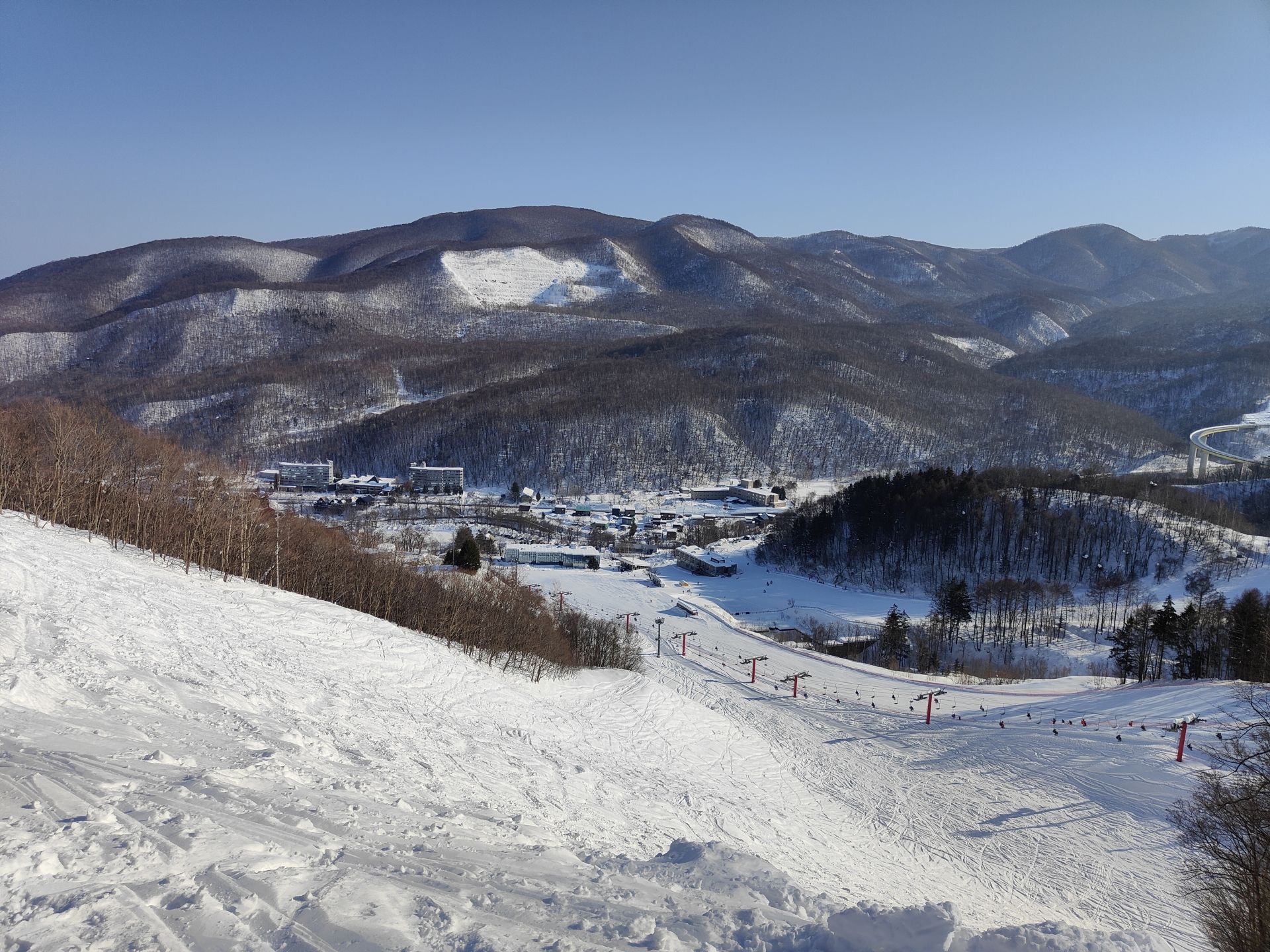Asarigawa Onsen
Ocean views, hush-hush Hokkaido pow

アサリ
Sea-to-Slope Vibes, Ten Minutes from Onsen
Asarigawa Onsen — “Asari” to the locals — is the under-the-radar option just uphill from Otaru. It’s a modest hill by Hokkaido standards, but the setting is unique: ride to the skyline and stare straight at Ishikari Bay. On bluebird days you’re literally skiing toward the sea; on storm days the coast sends you the goods. This is a locals’ mountain first and foremost — unfussy, friendly, and easy to navigate. The base is compact, parking is close, and you can transition from car to first chair in minutes.
History-wise, Asari has been around since the late 1960s, tied closely to the onsen village that sits at its base. The lift network is old-school — color-coded chairs rather than detachables — and the day-lodge scene is straight Japanese ski-jo: cafeteria curry, tune shop, rental counter, and families warming up between runs. Expect traditional touches like courtesy announcements and tidy queues, plus the occasional school program snaking by with neon bibs. Don’t expect international gloss; do expect decent value and a relaxed pace.

The vibe skews mellow and local. Weekends can see school groups and families at the base, but mid-week it’s you, the birches, and that classic Hokkaido “champagne pow” feel when temperatures cooperate. English isn’t widespread, though Otaru’s tourism scene and proximity to Sapporo keep essentials accessible. Signage uses simple icons, rental staff are helpful, and the trail map is easy to decode. If you want the full resort circus, go to Niseko; if you want head-clearing storm turns and a hot soak after, Asari delivers.
Pricewise, lift tickets are very reasonable for Hokkaido, and staying nearby in the onsen village or down in Otaru won’t break the bank. It hasn’t “blown up” in recent years — which is exactly why pow chasers keep it in the quiver for storm days or as a plan-B when Kiroro, Kokusai, or Teine go on wind hold. The value extends to food, rentals, and lessons, making Asari a savvy add-on to a Sapporo-based itinerary if you’re watching the budget.
Resort Stats
- Vertical520m (660m → 140m)
- Snowfall~8m
- Terrain 30% 40% 30%
- Tree Riding
- Lift Pass$36
- Lifts3 × double, 1 × triple
- Crowds
- Out of BoundsNot allowed
- Night Skiing
- Family Friendly
- Trails9
- Skiable Area~90ha
- VibeLocal, ocean views, onsen at base
Trail Map

Powder & Terrain
Asari stacks up storms off the Sea of Japan, and while the altitude is low, the aspect is mostly northeast, so snow holds better than you’d think. You’re skiing below treeline the whole time — great for visibility when it’s puking — and that coastal conveyor belt can refill lines quietly all day. Expect a touch more “coastal cream” during warmer windows, but frequent resets and light Hokkaido temps keep things playful. On frigid mornings the surface can run chalky-dry, then drift toward silky as the day warms.
The lift layout is simple and honest: four fixed-grip chairs named by color — Purple, Green, Red, Yellow — with the Yellow offering a mid-station unload. No gondolas, no high-speeds, and that’s part of the charm. It spreads people out, and the locals mostly stick to groomers. You’ll sniff out cold smoke along the sides after every refresh, and because there’s no high-capacity funnel, the best bits don’t get chewed up instantly. The pacing also favors longer rests — grab a stretch on the ride, scan the glades, pick a line, repeat.

On paper it’s nine courses with a 30/40/30 split; on snow it feels like two worlds: broad groomers that suit progression, and a network of glades, gullies, and short rollovers where advanced riders can draw their own lines. The Orange course spikes to about 36° in places, but the real fun is drifting off the groomed into low-consequence trees. Short pitches link into playful terrain features, and you can stitch mellow mini-spines after bigger storms. The sidewalls of the main groomers hold chalk late into the day, and gullies collect sneaky pockets that ride soft even after traffic.
Important to know: this is not a “gates” resort and the out-of-bounds is officially closed. There is a sanctioned tree-run/ungroomed presence and plenty of in-bounds stashes, but rope-ducking will get you in trouble — and rescue fees are real. If you’re looking to tour beyond, do it from proper trailheads with a partner, gear, and a plan. Inside the ropes, keep an eye on the patrol boards for avi control updates, wind warnings, or temporary closures after heavy snowfall.
Crowd factor is the secret sauce. Weekdays feel empty. Even on weekends, the base collects families while upper-mountain glades stay quiet. If the big boys shut for wind, Asari often spins — it’s lower and more sheltered — which makes it a clutch backup for storm chasers based in Otaru or Sapporo. First chair on Purple or Green after an overnight pulse and you’ll stack “fresh tracks” long past morning tea. When visibility tanks, duck into the birches flanking Red’s fall-line to ski by feel — the contrast is excellent and refills are common.
Who's it for?
Strong intermediates and advanced tree riders looking for relaxed, low-stress pow days will love Asari. It rewards line-hunters who don’t mind slower chairs if it means more untracked, and it’s a confidence builder for anyone stepping into soft-snow trees for the first time.
Intermediates get a ton of progression terrain: wide cruisers, consistent pitch, and forgiving snow. Park and pipe fiends won’t find much to chew on, and big-mountain thrill-seekers will run through the steeps quickly. If you need high-speed lifts, massive vert, or a sprawling gate network, you’ll find the hill limited — treat Asari as your storm-day ace rather than your whole trip.
Families do well here thanks to the compact base, friendly vibes, and gentle lower-mountain gradients. The magic carpet and learning zones are sheltered, and you can regroup easily between laps. Mixed-ability groups can split groomer and tree days without losing each other — everything funnels back to the same few points.
Accommodation
Stay in Asarigawa Onsen if you want the bathrobe-to-chairlift lifestyle. The namesake onsen hotel sits near the base with a proper rotenburo and even a Finnish-style sauna — easy soaking after a day of tree-hunting, and usually priced well below the marquee resorts. Rooms lean traditional, breakfast is hearty, and you can wander down to the baths in your yukata before bed.
If you’re with friends or family, the nearby cottage and condo clusters are the sleeper picks: self-contained units, some with private outdoor tubs, and room to stash gear to dry overnight. Self-cater, grill, and be five to ten minutes from first chair. It’s very “Hokkaido lodge” — practical, warm, and aimed at getting you back on snow early. Many units include parking, which is handy when you want to jump to Kiroro or Teine for a day.
Prefer more city energy and food options? Base in Otaru (10–20 minutes by car to Asari). Business hotels and boutique stays cluster around the canal; prices are friendly mid-week, and you can pair pow mornings with pastry runs and sushi dinners. Staying in Otaru also makes it easy to day-trip across the region without repacking — you’re central to Kokusai, Teine, and even Sapporo city nights if you want them.
Food & Après
On-mountain, expect a classic cafeteria with the greatest hits: katsu curry, shoyu ramen, karaage bowls, and steaming cocoa. It’s quick, affordable, and warm — exactly what you want between tree laps. The portions are generous, and you can usually snag a window seat to watch the snow stack up outside.
For proper après, roll down to Otaru. The city’s sushi game is serious thanks to daily catches from Ishikari Bay. A stroll along the canal delivers izakaya after izakaya; order sake warm on storm nights and graze on yakitori, grilled hokke, and buttery Hokkaido scallops. If you’re chasing something sweet, the patisseries are elite — Hokkaido milk and cream do heavy lifting — and you’ll find cheesecake and soft-serve that taste unreal after a cold day.
Nightlife is low-key and tasty rather than thumping. Think cozy bars with a dozen seats, craft beer served in brick warehouses, and mellow lounges where you can swap storm stories. If you want clubs and late-night chaos, Sapporo is the scene — but most Asari days end with an onsen soak, a good feed, and early lights out for another early start.
Getting There
Fly into New Chitose (CTS). From the airport, hop the rapid train to Otaru-Chikkō or Otaru station, then bus or taxi to Asarigawa Onsen — or just rent a car at CTS for full flexibility. From Sapporo, driving time is roughly 40 minutes depending on snow, and it’s only ~15 minutes up from central Otaru. The access road is straightforward but can glaze over in mid-winter — Hokkaido rentals come on studless winter tires; chains are rarely needed, but drive defensively and keep your distance.
Parking at the ski area is free and close enough to boot up at the car. If you’re using public transport, time your return with the late-afternoon buses; services thin out in the evening. Ride-share isn’t ubiquitous, so save a local taxi number if you’re staying in Otaru and want a quick pickup after après.
Pro tip: base yourself in Otaru with a rental car and keep Asari, Kiroro, Kokusai, and Teine on your weather board. When the mountains are howling, Asari’s sheltered aspects can stay open. When it clears and temps drop, you can chase colder smoke at the higher-elevation neighbors.
Japow Travel Tips
- Lift hours: Typically around 9:00–17:00. Night skiing is not offered. Holidays and weekends may see slight hour extensions.
- Lessons & rentals: Solid rental fleet for piste and powder; English availability varies, so go early and be patient. Private lessons in English can be arranged via Otaru-based outfits.
- OB policy: Closed means closed — rope-ducking risks pass revocation and rescue fees. Inside the ropes you’ll still find fun trees and ungroomed sections after storms.
- Snow & weather: Coastal pulses bring frequent refreshes; lower elevation means occasional heavier snow or mid-winter wind crusts on exposed rolls. Trees hold quality well.
- Weekday edge: Mid-week is blissfully quiet. Weekends bring families to the base, but upper-mountain off-piste stays surprisingly empty.
- Cash vs card: Japan is increasingly card-friendly, but keep some yen on hand for small snacks, locker coins, and rural tolls.
- Nearby hits: Kiroro for big snow and bowls, Sapporo Kokusai for longer lines and deeper interior feel, and Teine for steeper shots and city views.
Verdict: Quiet Pow With a View
Asari is the Hokkaido side quest that keeps paying out: a peaceful locals’ hill with real storms, trees for days, and that surreal ocean backdrop. Slot it into an Otaru or Sapporo base, pull it on when the wind’s howling up high, and enjoy freshies without the fanfare. It’s not flashy — but it is fun, affordable, and chock-full of short, creative lines that make you grin. If you measure a day by smiles, not stats, Asari belongs on your shortlist.